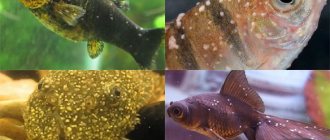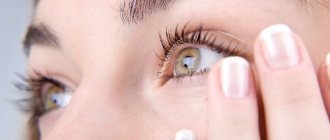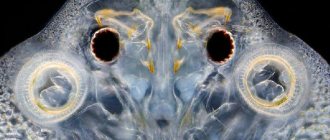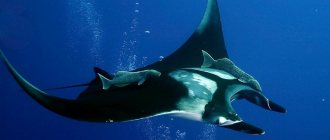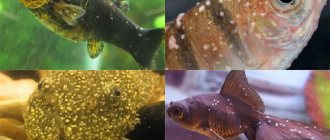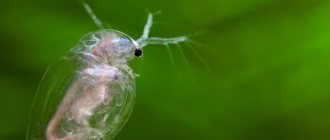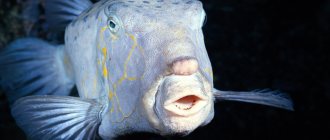Black spots on fish, what are they?
Black spots on fish are nothing more than a disease called post-diplostomosis or black-spot disease.
Postodiplostomosis is a common fish disease, which is manifested by the appearance of black spots of various sizes on the body of fish, from which the disease received its original name - black spot disease .
It is the metacercariae of the trematode Posthodiplostomum cuticola that causes black-spot disease in fish.
Symptoms and causes of the disease
If white dots appear on the surface of the body of fish in an aquarium, this is the main symptom of the emerging disease. Initially, the spots appear in small quantities, then every day the white dots become more and more numerous. The white dots on the fish are no larger than a grain of semolina. Ichthyophthyriosis in fish is developed by the bacteria ciliates Ichthyophthirius entering the aquarium along with food, soil and water. Bacteria attach to the scales of fish. The semolina on the fish are not actually white spots, but tubercles through which the parasites come out.
- restless behavior;
- fish rub their bodies against objects, plants and soil;
- when internal organs are damaged, pets become passive to external stimuli, their appetite disappears, they are often on the surface of the aquarium, swallowing air;
- when the cornea of the eye is damaged, blindness develops;
- the color of the scales and body fades;
- the scales are covered with a white coating.
Without immediate action, the inhabitants of the aquarium may die as a result of lack of oxygen and damage to the epithelium of a large area.
The most frequently affected species are viviparous individuals. This bacterium is harmless to humans.
Causes of fish infection with semolina:
- live food, it is especially difficult to remove parasites from plants brought from tropical places;
- the appearance of new fish in the aquarium;
- dirty soil;
- as a result of poor quality and irregular cleaning of the aquarium: the deposits on the walls should be cleaned, the filter should be washed;
- cold water;
- temperature changes in the aquarium;
- stress.
At the initial stage of infection, before the appearance of tubercles, Ichthyophthirius (another name for the disease) cannot be seen with the naked eye.
Development of post-diplostomosis
More than 150 years ago, Professor D. Nordman first described trematode larvae, but then their nature was not deciphered. It is now known that the development of trematodes occurs with the participation of two intermediate hosts - mollusks and fish.
Adult trematodes, which parasitize the intestines of gulls, herons and other fish-eating birds, lay eggs, which, along with the birds' feces, end up in the water. They then hatch into microscopic larvae called miracidia. Miracidia penetrate the first intermediate host - a mollusk . It is in the body of the mollusk that the parasite multiplies and its larvae again enter the water and attack the fish, their second intermediate host , turning into a metacercaria and infecting its various organs. The final host is a fish-eating bird that becomes infected when it eats fish infected with metacercariae. In the intestines of birds, the larvae develop into mature worms, which lay eggs, and the whole cycle begins all over again.
How to treat ichthyophthyriosis
It is important to treat not only the aquarium fish themselves, but also to take appropriate measures to disinfect the aquarium. Previously, semolina in aquarium fish was considered easily curable, but nowadays it is becoming increasingly difficult to treat, as parasites adapt to methods of fighting bacteria. With the appearance of the first symptoms of the disease, the fish in the aquarium may die after a week, so semolina should be treated immediately.
It is possible to cure fish either by moving them to another container or by leaving them in the aquarium.
Semolina treatment
Treatment methods for whiteheads:
- Treatment of ichthyophthyridiosis with salt
- "Malachite green"
- Hydrogen peroxide
- A mixture of the medicine “malachite green” with other
Treatment of ichthyophthyridiosis with salt
This method is suitable for treating ciliates brought from local waters, since tropical bacteria tolerate salt water well. Salt should be taken at the rate of one tablespoon per 10 liters of water, while gradually raising the temperature to 32 degrees. The duration of treatment is 14 days. After therapy for 30 days, it is necessary to change the water by 30% every week. Efficiency is achieved by reducing the amount of oxygen for the life of ciliates, and the increased water temperature prevents their reproduction.
"Malachite green"
The effectiveness of the drug is reduced by the fact that a concentration of 0.09 mg/l is unfavorably tolerated by fish and plants, and a decrease in concentration leads to a decrease in effectiveness. And also an indicator of no more than 0.06 mg/l is recommended if the aquarium contains young fish and representatives without scales. It is administered gradually until the rash disappears, and for several days after visible signs disappear. With each new addition of medicine, it is necessary to change the water.
Hydrogen peroxide
It is recommended to add 3% peroxide solution to 1 ml per 10 liters of water. It will saturate the water with oxygen, and the inhabitants will breathe easier. It is recommended to carefully observe the dosage; excessive concentrations of hydrogen peroxide can harm the fish or burn their fins.
What fish can you find black dots on?
Black spots can be found in different types of freshwater fish - in total, more than 60 species.
However, they are most often found in:
- bream (bream),
- silver carp,
- chebaka,
- roaches,
- carp,
- carp,
- rudd,
- perch,
- grass carp,
- chub
and in many other fish species. An interesting fact is that black spot disease is very rare on pest fish imported from abroad.
Is it possible to eat fish with black spots?
At first I thought, is it worth writing about this? Will this note break anyone’s stereotypes about the “ideal world of nature”? Where the presence of certain components of the ecosystem is strictly necessary and especially useful, both for the entire ecosystem as a whole, and for each of its members individually (and most importantly, for humans too). However, even if it “breaks”, it will not affect nature and its components in any way, and for “idealists” (if there are any) it will add a little more understanding about the structure and relationships in the world of living nature.
In which bodies of water is post-diplostomosis common?
Postodiplostomosis is usually widespread in natural reservoirs, ponds and spawning farms in the southern regions of the country, where herons are most abundant.
The trematode metacercaria Posthodiplostomum cuticola is a heat-loving parasite. The minimum temperature for its development is 10 °C. As the temperature rises, development accelerates. The optimal temperature is about 24 °C. This is precisely why post-diplostomosis is observed mainly in the southern regions, less often in the central regions, and does not occur at all in the north. Although fish infection occurs most often in the spring-summer period, cases of infection cannot be excluded in the winter-autumn season.
Prevention
To prevent the disease, it is necessary to follow safety measures:
- quarantine for new inhabitants of the aquarium, including plants;
- ensuring hygiene of the aquarium; for this there must be a separate siphon, net and other accessories.
When purchasing a new pet, it is forbidden to immediately place it in a common aquarium. Even a careful inspection before purchase does not guarantee health; fish do not always show white spots in open areas. Ciliates can hibernate on the skin or in the mouth and gills. During transportation and placement of a pet in a new aquarium, the fish experiences stress, as a result of which the disease becomes more active and begins to actively develop.
The new pet must be placed in a special quarantine aquarium, one pet should be added to it and wait a few days, after which the newcomer can be placed in a common reservoir.
To avoid contamination of the entire aquarium, it is important to monitor the behavior of the inhabitants when something new appears in it. Outbreaks of the disease occur regardless of the time of year, all year round. However, it has been noted that the disease is especially common in spring and summer.
Contagious diseases
Contagious diseases of aquarium fish are dangerous and life-threatening for the entire aquarium. Contagious diseases are easily transmitted from one aquarium fish to another. To make a diagnosis, you should carefully monitor the external changes of the individual and its behavior.
White-skinned
When infected with this disease, aquarium fish change their appearance. The color becomes lighter, and in some cases turns white. Floating occurs on the surface of the vessel. For treatment, a separate container with chloramphenicol is used.
White-skinned fish
Branchiomycosis
Branchiomycosis appears as dark stripes on the gills. The behavior of the fish becomes inactive, it swims only near the surface of the water, there is no appetite, the individual hides and hunches over, while the fins are pressed. Treatment is carried out in septic tanks using copper sulfate and rivanol.
Hexamitosis
When aquarium fish become infected with this disease, the anus becomes inflamed and erosion of the epidermis appears, which looks like mucous perforated ulcers. The disease is contagious and requires serious long-term drug treatment.
Gyrodactylosis
The main external symptoms of the disease are expressed by pressing the fins. The fish swims near the surface, the movement is rocking, the appetite disappears, the individual rubs against the surface of hard objects, the fins are destroyed. Treatment can be carried out in a common vessel using medications.
Glucose
Affected individuals begin to float on their sides, and growths appear on the skin, which subsequently rupture. The disease is accompanied by bulging eyes. There is no cure; all individuals must be destroyed.
Fin rot
The main symptoms are clouding of the fins, their edges acquire a white-blue tint. Further, the disease is accompanied by rotting of the clouded parts. To treat fin rot, bactericidal medications and baths are used.
Fin rot
Dactylogyrosis
Sick fish move on the surface of the reservoir, the gills become covered with mucus and become of various colors, often the gill filaments grow together. Affected individuals are treated in a common aquarium using bicillin, salt and formalin.
Dermatomycosis or saprolegnia
Often occurs as a secondary disease as a result of weak immunity. The skin and gills are affected, and sometimes internal organs are affected. The fungus is visible in the form of white threads on the epidermis and gills. If dermatomycosis is a primary disease, it is treated with medicinal baths.
Ichthyosporidiosis
Ichthyosporidiosis affects all tissues, with the exception of cartilage and bone tissue. Sick pets move spasmodically, itch, do not eat food, have bulging eyes, and fins are destroyed. No treatment is used. All individuals are destroyed.
Ichthyophthyriosis or decoy spot disease
The main symptoms of semolina include frequent breathing and itching, as a result of which the fish itch on hard surfaces, subsequently white grains similar to semolina appear on the body. For treatment, bactericidal drugs, water changes, and raising the temperature are used.
Lepidorthosis
With lepidorthosis, the scales are raised, as bubbles with liquid inside form under it. As the disease progresses, the scales fall out and the fish dies. It is possible to accurately diagnose the disease only in laboratory conditions. The treatment is effective only at the beginning, when small areas of the body surface are raised.
Trichodinosis
With trichodinosis, fish rub against the substrate and pebbles, and the skin becomes covered with a light-colored coating. The gills change color and become covered with mucus. For treatment, the infected individual is transferred to a tank with a liquid temperature of at least 31 degrees with the addition of salt at the rate of 40 grams per 20 liters.
Peptic ulcer
Accompanying symptoms of ulcers are dark spots on the body that turn into ulcers. But bulging eyes, bloating and lack of appetite also appear. Treatment is necessary immediately, for which streptocide or potassium permanganate is used.
Bug-eyed
With bulging eyes, the eyes become very swollen, and cases of eye loss are common. The disease occurs together with other infectious infections, for example, dropsy. The method of treatment directly depends on this.
Dropsy
Dropsy is manifested by severe bloating of the abdomen, and the scales begin to puff up. The disease is accompanied by shortness of breath and lethargy.
Furunculosis
Furunculosis manifests itself as small dark spots, which over time become red ulcers. Their shape and size are different.
Furunculosis
Plistophorosis
The main sign of infection is a jerky movement upside down. There is no appetite and coordination of movement is impaired. The disease is incurable and therefore requires the destruction of infected individuals.
Mycobacteriosis
Disease of viviparous individuals. Ulcers and abscesses appear, blindness may occur, and the skin may become covered with black dots. Treatment is effective only at an early stage.
Is “ink” fish dangerous for people?
In fact, black spots on dried fish are completely safe for humans. After all, the larvae found in fish scales do not carry dangerous toxins for us. In addition, a person cannot serve as a host and place of residence for a parasite.
But, if you follow all the rules, it is better to heat-treat such fish.
If you suddenly catch a specimen with black dots from a pond near your home, there is no need to panic. But it’s still worth taking care of the fish. For example, reducing the number of shellfish in a pond with the help of black carp or catching infected fish. Next year you can start stocking the reservoir with healthy fish.
There is even more interesting information about
fishing and hunting on the website velesovik.ru and in our VKontakte .
We invite you to go to the wonderful world of fishing and hunting at any time and in any weather.
Video
Poisonous Puffer Fish Caught, Tricked and Released
24 HOURS ON THE OPEN SEA! *VLAD A4 CAME INTO A STORM*
What to do if a Xenococcus appears in the Aquarium. Green dots, plaque on leaves and plants
In the USA, a sixteen-year-old teenager was driven by e-cigarettes to undergo a lung transplant.
Advice on what to do
When diagnosing one of the many different types of white or light spots, it is especially important to determine whether the fish is new or has been with you for a long time. It should be noted whether there are other signs of the disease present - for example, a fish with white spots itches, but a fish affected by lymphocystosis does not.
The species to which the fish belongs is important (for example, cichlids and cyprinids do not get guppy disease or neon disease!), as well as the development and contagiousness of the disease (ichthyophthyriosis develops quickly, while others develop much more slowly). These differences are discussed in the relevant sections.


